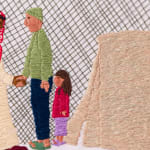-
Artworks
Aya Haidar British-Lebanese, b. 1985
Zaatari Camp, 2024Embroidery on cotton30 x 30 cm
11 3/4 x 11 3/4 in$ 6,000.00Further images
Exhibitions
Through the medium of embroidery, Haidar portrays scenes that convey the survivor stories recounted by women in refugee camps during her extensive engagement with displaced communities spanning over two decades. These pieces unfold narratives of loss, grief, resilience, and abuse, portraying these women as inadvertent protagonists thrust into the frontline of their own battles.
Amongst Syrian refugees in Zaatari Camp in Jordan, fathers would commonly prostitute their daughters to outsiders for money to be able to buy food and resources for the family. This was particularly common amongst the most deprived families with girls as young as 13. This piece serves to speak of the unspoken, to shame the practice but also to pay tribute to the young girls whose bodies have extended the battlegrounds of the conflict.
Literature
Through the medium of embroidery, Haidar portrays scenes that convey the survivor stories recounted by women in refugee camps during her extensive engagement with displaced communities spanning over two decades. These pieces unfold narratives of loss, grief, resilience, and abuse, portraying these women as inadvertent protagonists thrust into the frontline of their own battles.
Amongst Syrian refugees in Zaatari Camp in Jordan, fathers would commonly prostitute their daughters to outsiders for money to be able to buy food and resources for the family. This was particularly common amongst the most deprived families with girls as young as 13. This piece serves to speak of the unspoken, to shame the practice but also to pay tribute to the young girls whose bodies have extended the battlegrounds of the conflict.
2of 2









